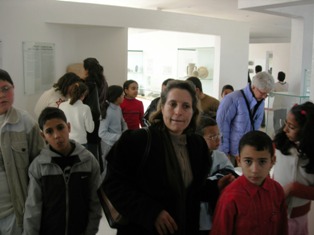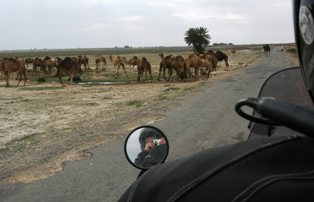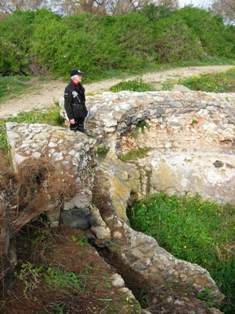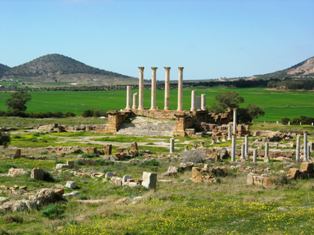A Tale of Plumbing Old and New
Mike and Jo find their feet in Tunisia and come to grips with the plumbing.1 Feb - 9 Feb 08
After our initial introduction to Tunisian bureaucracy, the country has lived up, and down, to our expectations. Jo and the Elephant (being aliens) could only get 30 days on their visas, and with the ferry schedule reduced in winter, we needed to keep moving to get a handle on the country and get out on time.
Tunisia has about 3000 years of recorded history, much of it Punic and Roman. I have always had an interest in these periods since studying Ancient History in school 40 years ago. The Punic wars, in particular, had been the source of great misery as I also studied Latin and they were the subject of endless translations from Latin to English.
Much of the history is contained in a large number of archaeological sites across the country. As these have been excavated, many of the important finds have been removed for display to the Bardo Museum in Tunis. Despite our dislike of most big cities, we decided to stay over in Tunis to see both the Bardo and the ruins of ancient Carthage which are now in the northern suburbs.
The Bardo was a well run, reasonably priced and interesting place. We found our way out there on the Tunis tram system that was cheap and efficient.

Jo finds out the true meaning of the expression of toey as a Roman sandal with this relic of a 7.5m statue of Jupiter from the Roman city of Thuburbo Maius. We visited the site later in the week and saw the temple where it was found.

Many Roman mosaics had been recovered from the various digs and displayed in the Bardo. Some are amazingly fresh.
We had a little touch with the familiar when we found the following mosaic depicting a scene from the Odyssey. The mosaic tells the story of Ulysses and the Sirens. In the legend, any sailor who heard the sirens song, or laid eyes on them, would be drawn to his death. To avoid this, Ulysses had himself tied to the ships mast while the Argonauts had their ears stuffed with wax and were ordered to look away. The cunning Ulysses was terribly tormented, but he and the lads survived.

Mike meets Ulysses. The detail in the mosaic, taken from Dougga, was amazing and true to the story, although John Cominos may not agree.

The detail of the sirens was a little disturbing. Good body, shame about the legs.
Further south in the holy city of Kairouan, we found a copy of a section of the Ulysses mosaic in a park.

Is there no end to the tackiness! Who would buy a knock-off copy of a Roman mosaic?
For the Carthage ruins, we caught a tram and then a suburban train. Once again the system was cheap and worked fine, although it was crowded.
At the Carthage Museum we had an encounter with another of our associates from home.

This Roman sculpture of Silenus, a follower of Bacchus, shows the effects of a lifetime of excessive drinking and bad behaviour. You can make up your own mind about who modelled for it.
In the south of the country at the city of El Jem, we found several other mosaics featuring Silenus.

Here Silenus is mounted on a camel looking the worst for wear, and

being carried to his waiting donkey and his nurse.

Although it was Sunday (officially a holiday) a few classes of school kids descended on Carthage while we were there. Jo reckons they were about as interested in the exhibits as most school kids on most excursions.

Our final stop at Carthage was the American War Cemetery located in the same area as the ruins. Our friend Russ Crumrine had told us about it. Like the many Commonwealth cemeteries we have visited, it was beautifully maintained and tranquil. In the summer, bus loads of American tourists descend on the place from the cruise ships that ply the Med.
Both these outings had been excellent and we had stayed at a comfortable, friendly pub in the city so our time in Tunis was enjoyable. We were, however, disappointed to find that the Tunisians are as hopeless as plumbers as the Moroccans and the Spanish (and to some extent the French who probably taught them everything they knew). Basically, nothing works properly. Drains dont drain and everything that gets the water to the drain is ad hoc and poorly maintained.
Knowing how well the Romans had managed the hydraulics of their towns, we set out to discover some plumbing history on our way around. So, we headed out of Tunis for a quick tour of Cap Bon and our first stop was the Phoenician site of Kerkouane. On the way we started getting used to Tunisian road conditions.

At the first overnight stop in the village of Kélibia we parked the Elephant on the footpath outside the front door. We had already found out the horrible truth about road behaviour. In Tunisia, the only things with any road sense are...

the camels, which hate Elephants and always give us a wide berth. To be fair, the sheep are also pretty good at staying off the road. The humans, on the other had, are suicidal!

2500 years ago, in an idyllic spot by the sea, the Phoenicians built a small trading town at Kerkouane (actually, its original name has been lost). It had

reticulated water from a spring through an aqueduct to a cistern and on to bathrooms like this one

with baths like these. Water was moved through standard sections of channel, like these

which were series, if not mass, produced. Laundries and commercial washing facilities like this

were joined to the system, while the poor had access to communal latrines and wash houses. Storm water

ran off through guttering like this, and collectors

like these. It all ended up at a sewerage outlet like this

some distance away.
Elegant!!

Further south at the Roman site of Thuburbo Maius (home of the big foot) we were free to wander without restriction. We found

huge cisterns fed by an aqueduct from mountain springs 40 km away, and

wide streets with drains running under them. All manner of plumbing fixtures

with heated baths

for the winter, and non-heated for the summer.

Large areas of the wet floors were covered with mosaics (no, Jo didnt walk on this one honestly). And the storm water drains were sophisticated enough to filter the rubbish.

The same aqueduct that serviced Thuburbo Maius marched more than 130 km across the country to feed the mighty cisterns of Carthage. The cisterns are nearly 1 km in length and are truly impressive.

Fantastic!!
At El Jem we visited the huge colosseum

and the site of some Roman houses nearby, where we found an elaborate system of collecting and filtering rainwater using standard plumbing fittings

like this lead pipe, or

this T connector, or

this joining piece.
The water was collected in a series of ponds, like these

that overflowed one into another to settle and clear the water, with the residual flowing onto the gardens. To top it off, the pond surrounds were used as garden spaces and are decorated with beautiful mosaics

like this.
All of which provided an elegant solution to the citys shortage of water.
So dont ask me why, 2000 years later, now deep in the Tunisian heartland, we are yet to find a pub with drains that drain.
